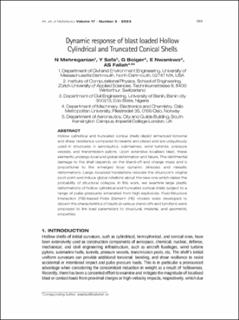Dynamic response of blast loaded Hollow Cylindrical and Truncated Conical shells
Peer reviewed, Journal article
Published version
Permanent lenke
https://hdl.handle.net/11250/3099613Utgivelsesdato
2023Metadata
Vis full innførselSamlinger
Originalversjon
The International Journal of Multiphysics. 2023, 17 (3), . 10.21152/1750-9548.17.3.269Sammendrag
Hollow cylindrical and truncated conical shells depict enhanced torsional and shear resistance compared to beams and plates and are ubiquitously used in structures in aeronautics, submarines, wind turbines, pressure vessels, and transmission pylons. Upon extensive localised blast, these elements undergo local and global deformation and failure. The detrimental damage to the shell depends on the stand-off and charge mass and is proportional to the emerged local dynamic stresses and inelastic deformations. Large, localised translations relocate the structure’s original pivot point and induce global rotations about the new one which raises the probability of structural collapse. In this work, we examine large plastic deformations of hollow cylindrical and truncated conical shells subject to a range of pulse pressures emanated from high explosives. Fluid-Structure Interaction (FSI)-based Finite Element (FE) models were developed to discern the characteristics of blasts at various stand-offs and functions were proposed to link load parameters to structural, material, and geometric properties.

